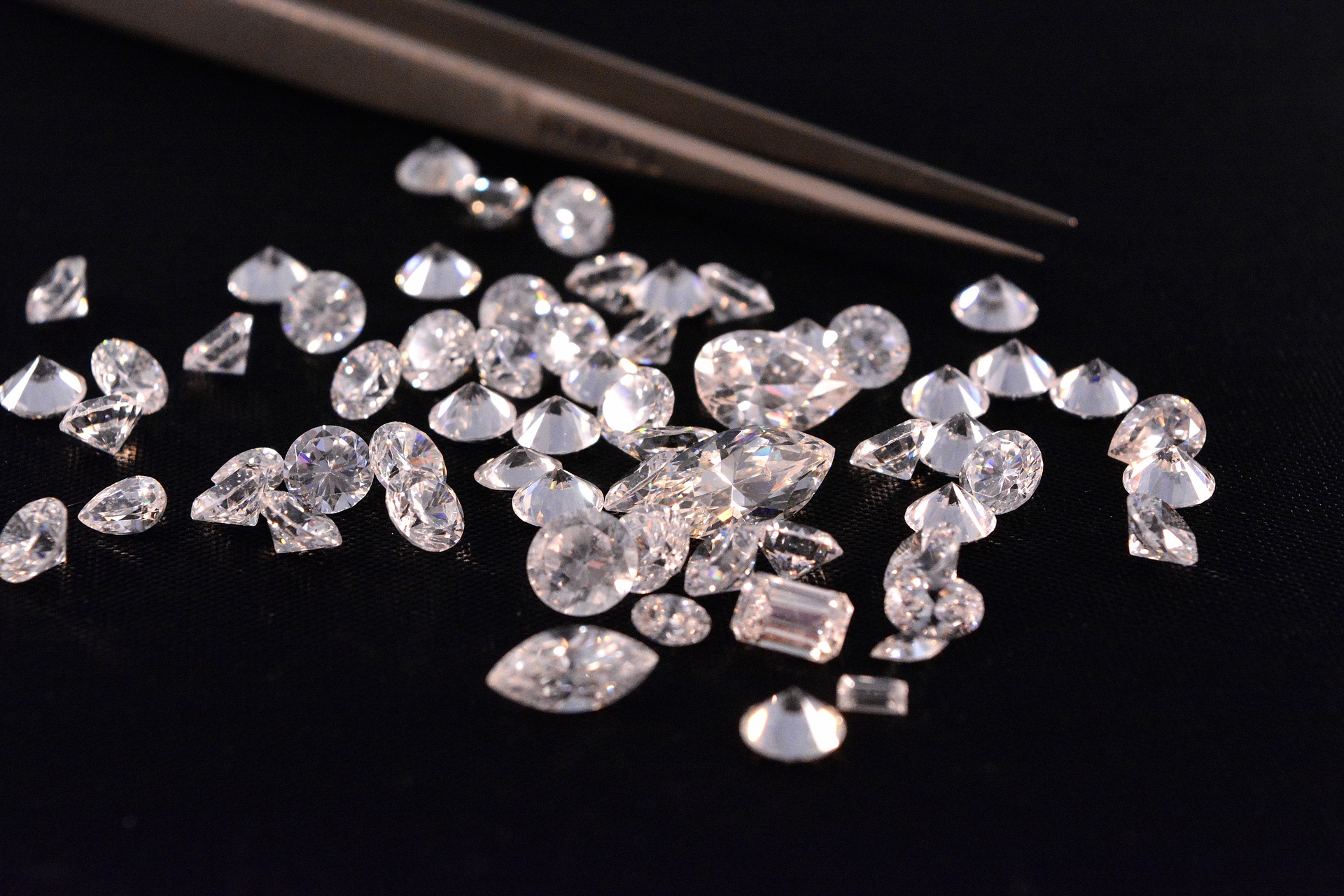Jewellery Industry Accused of Silence over Russian Diamonds

Insiders say current sanctions do nothing to halt flow of Russian gems to the west because majority are exported rough and get reclassified in India
In the photographs, Vladimir Putin stands with a faint smile on hisface. Behind him, the enormous cavern of a mine stretches out, the earth ringed red and ochre. In other photographs from his visit to the Siberian mining city of Mirny, the Russian president is pictured meeting local miners and inspecting one of the dark stones they cut from the earth.
Soon, the rock in his hand will be swept into a vast and complex global supply chain – refined, cut, and polished until it shines and catches the light. Its final form is a glittering diamond – a tiny piece of an industry worth tens of billions of dollars.
Russian mines are at the heart of that industry, making the country the world’s largest producer of diamonds, accounting for about 30% of the global market.
As Russia’s devastating war on Ukraine drags on, the question of whether to keep buying and selling those diamonds is a quandary for jewellers, diamond companies and the industry bodies set up to regulate them – many of which depend on Russia’s state-controlled diamond sector for supply. In the meantime, industry insiders say US sanctions will do little or nothing to stop the flow of diamonds from Alrosa, Russia’s enormous state-backed mining monopoly, to the west.
“These are objectively conflict diamonds: they’re funding an armed conflict against a peaceful neighbour, by a state actor,” says Cristina Villegas, director of the Mines to Markets program at Pact, a development NGO. Russian diamonds do not fit the narrowest industry definition of “conflict diamonds”, which refers to those used to fund rebel groups, but Villegas says they clearly fit the spirit of the term.
“The situation with Russian diamonds is that they really became conflict diamonds overnight,” she says – and so far, many major industry groups have remained silent on whether responsible buyers should continue the sourcing. “These things take time to settle on new definitions. But the silence is striking – and it’s hard not to presume it’s because much of the industry is hoping that this goes away or it’s forgotten.”
Close links to the Kremlin
Almost all Russian diamonds come from Alrosa, which says it accounts for 99% of all rough diamonds produced in the Russian federation. A third of Alrosa’s shareholding is directly owned by the Russian state, and another third by regional governments – the Russian republic of Yakutia and its administrations, where many mines are located.
Alrosa’s corporate leadership is also closely linked with the Kremlin, and Sergei Ivanov, its chief executive, was specifically targeted by US sanctions. Ivanov’s father is Sergei Borisovich Ivanov, reportedly one of Putin’s closest allies and formerly a Russian minister of defence, KGB colonel general and Putin chief of staff. Alrosa is a significant earner for its shareholders. The company reported sales of $4.16bn in 2021, resulting in a net profit of 91bn rubles ($943m).
Independently of Alrosa, the Russian state has an enormous diamond stockpile – the Gokhran – that it has historically used to regulate the diamond market, buying up excess and selling during shortages. “They have, since the 1990s, been purchasing diamonds in order to manage the pricing,” says Dr Hans Merket, a conflict diamonds researcher at Belgium institute IPIS. Gokhran holds periodic auctions of gemstones from state stockpiles, with six auctions in the first half of last year. Diamond.net reported that revenues from one sale came to $139.2m, according to Russia’s ministry of finance. “It’s a state secret, how much diamonds are in that stock,” Merket says. “If they would start selling those diamonds, that could be an important source of revenue.”
Even as the United States introduces sanctions on Russian diamonds, however, industry insiders say their current wording does nothing to halt the flow of Russian gems. This is because the vast majority of Russian stones are exported rough. From there, most will go to be cut and polished in India, which processes about 90% of the world’s rough diamonds. Under US customs rulings, this is considered a “significant transformation” – so polished diamonds can be imported as an Indian product, not a Russian one. There is so far no indication that by buying Russian diamonds through India, US companies would breach sanctions.
“The sanctions – unless they deepen – are not going to affect the normal business,” Martin Rapaport, a high-profile figure in the diamond industry and founder of RapNet, the world’s largest online diamond trading network, said in a presentation to the industry last week.
“The flow of diamonds from Russia to India to America will continue unabated,” Rapaport told the Guardian. “The sanctions are essentially very ineffective. They don’t do anything. This is not going to stop Russian diamonds.”
In India, government officials say Alrosa has told them business will continue as normal. Colin Shah, chairman of the Indian government’s Gem and Jewellery Export Promotion Council, told the Economic Times that Alrosa had written to reassure them sanctions would not stop the flow. “Alrosa has assured that they are running their business as usual … They will be fulfilling all their obligations to their clients in any part of the world,” Shah said.
‘Let society decide’
Any decisions to cut off trade with Alrosa are likely to fall to individual companies, industry bodies, or distaste from the general public. But Alrosa has become a key source for many of the world’s largest jewellers – many of whom remain tight-lipped about whether they will continue to buy Russian diamonds. In the weeks immediately following Russia’s invasion of Ukraine, Alrosa deleted its long-term “our customers” list – usually prominently and publicly displayed – from its website.
Archived versions of the Alrosa list, however, reel off a number of prominent international diamond traders and jewellers. Over the past four years, the firm has boasted of long-term contracts with more than 60 firms, including Signet Jewellers, the world’s largest retailer of diamond jewellery, New York firm Leo Schachter, and iconic luxury brand Tiffany & Co. At time of writing, just one of the large western firms listed as a longtime Alrosa customer – Signet Jewellers – has made clear statements on whether it would stop sourcing Russian diamonds. Brilliant Earth, a smaller firm branded on responsible sourcing, said last week it would remove Russian diamonds for sale.
In a memo to suppliers on Thursday, Signet said it had “halted all trade in precious metals and diamonds that originate from such sanctioned Russian sources, and you are therefore requested to stop supplying the same to Signet even though the country(s) in which you operate may not have imposed sanctions on Russian precious metals and diamonds”.
Wider action against Alrosa could have unintended consequences: a blanket ban could hit the Indian cutting industry, for example, or Yakutian mining communities. In the past, some of the delicate work of deciding what does or doesn’t meet standards for “responsible” sourcing has been taken up by industry bodies. But now key councils set up to reform and regulate the sector have stayed mostly silent on whether trade with Alrosa should continue.
The Kimberly Process (KP), originally set up to try to keep conflict-connected diamonds out of the supply chain, has issued no public warnings on Russian supply. The Kimberley Process Civil Society Coalition has called on the KP to “establish if and which measures are required to secure that diamonds produced in Russia or by Alrosa do not contribute to financing this conflict”. At time of writing, KP had yet to issue any formal rulings in response.
The Responsible Jewellery Council, one of the industry’s most prominent bodies, aims to set industry standards for supply chain responsibility and “promote trust in the global jewellery and watch industry”. Its code of practice states that members must ensure when doing business that “beneficial owners are not named on relevant government lists for individuals or organisations implicated in … or those financing conflict”.
It’s been a deafening silence
Cristina Villegas, of NGO Pact, on the industry response to Alrosa diamonds
Alrosa has stepped down from the council’s board, but at time of writing remained a member in good standing and maintained RJC certification. The council has issued guidance that members should comply with sanctions, but did not respond to questions on whether it would take further action against Alrosa based on its code of practice. The board and founders include companies that have been major Alrosa’s customers, including Tiffany & Co, Signet and Leo Schachter.
Brad Brooks-Rubin, a strategic adviser for the Responsible Jewellery Council and former special adviser for Conflict Diamonds to the US Department of State, published a public statement saying: “Given the role of a Russian state-owned diamond mining company in the global supply chain … The decisions – or, more specifically, the lack thereof – from the Responsible Jewellery Council regarding this company and overall crisis so far are insufficient.”
He said: “This is my own personal statement and admittedly one made outside established processes, but I think it is important to be transparent.”
Brooks-Rubin told the Guardian the council’s code of practice “provides multiple bases for action against Alrosa”. “I hope there will be a formal investigation into those issues and that action will take place.”
Technical compliance with sanctions was not the same as responsibility, he said. “If a company wants to say, ‘We are continuing to source diamonds from Alrosa, because if we don’t, we won’t have any products to sell you’… Let the consumer decide, let society decide whether or not that’s OK,” he said. “But at the moment we have a scenario where … we don’t necessarily give an answer about what we’re doing. And I think that’s coming up short.”
The Guardian contacted a number of Alrosa customers. Tiffany & Co and diamond firm Leo Schachter did not return requests for interviews or comment. RJC chair David Bouffard, of Signet, did not return requests for an interview. RJC executive director Iris Van der Veken did not respond to questions regarding Alrosa’s continued membership, or whether the council had told members to pause purchasing Russian diamonds, but referred to a press release indicating Alrosa had voluntarily stepped down from the board and committees, and correspondence to members asking they “strictly follow all applicable sanctions issued in your jurisdictions”.
Villegas says key industry bodies’ silence on the matter of Alrosa diamonds has been remarkable – and could taint consumers’ perception of diamonds for years to come. “All the work that has been done over the years to try to turn the industry reputation around, and show meaningful progress towards diamonds that do good [could] be undermined by current silence,” she says.
“From the biggest players that have responsibility roles in the industry, or label what’s quote-unquote, responsible? It’s been a deafening silence.”
Article credit: https://www.theguardian.com/world/2022/mar/19/jewellery-industry-accused-of-silence-over-russian-diamonds
